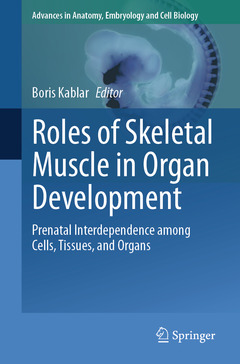Roles of Skeletal Muscle in Organ Development, 1st ed. 2023 Prenatal Interdependence among Cells, Tissues, and Organs Advances in Anatomy, Embryology and Cell Biology Series, Vol. 236
Coordonnateur : Kablar Boris

Muscle is the only tissue of the four basic types that make the body that can be completely ablated while allowing fetal survival. This book is a result of 25 years of research employing engineered mouse fetuses with no skeletal muscle, a model system that provides a unique opportunity to study body development holistically.
A systematic anatomical analysis of such fetuses have shown that several anatomical locations are affected by the absence of the skeletal muscle. This book contains a summarized description of affected anatomical locations such as the alveolar lung epithelium, motor neurons and giant pyramidal cells in the CNS, cholinergic amacrine cells of the retina, and type I hair cells of the crista ampullaris. Several specific bioinformatics and systems biology interventions are also described. The book provides an update on skeletal muscle development, musculoskeletal developmental interactions, trophic relationships between the skeletal muscle and the motor neurons, mechanics of lung development, functional development of two special senses, eye and ear, and finally, skeletal muscle-related reasons for human fetal akinesia and its consequences.
This volume in the Advances in Anatomy, Embryology and Cell Biology series stresses the need to think about the developing body and its organs in terms of their mutual interdependence, and to think about diseases, such as pulmonary hypoplasia, amyotrophic lateral sclerosis, or cleft palate, in terms of that interdependence. Directed to developmental biologists, neuroscientists, tissue engineers and health professionals, this book exposes the ideas of interorgan communication and interdependence in homeostasis and disease.
Chapter 1 Skeletal muscle’s role in prenatal inter-organ communication: a phenogenomic study with qualitative citation analysis.- Chapter 2 Roles of skeletal muscle in development: a bioinformatics and systems biology overview.- Chapter 3 Overview of head muscles with special emphasis on extraocular muscle development.- Chapter 4 Building a co-ordinated musculoskeletal system: the plasticity of the developing skeleton in response to muscle contractions.- Chapter 5 Upper and lower motor neurons and the skeletal muscle: implication for the Amyotrophic Lateral Sclerosis (ALS).- Chapter 6 Mechanics of Lung Development.- Chapter 7 Angular and linear accelerations, ear, and the skeletal muscle
Boris Kablar is a tenured (2005) full professor (since 2012) in the Departments of Medical Neuroscience, Anatomy and Pathology, Faculty of Medicine, Dalhousie University, Halifax, Canada, with an expertise in Human Histology, Embryology, Developmental Biology and Mouse Pathology and Phenogenomics. He has an MD (1987, Zagreb; 1995, Trieste) and a PhD (1998, Zagreb and Pisa) from Universities of Zagreb (Croatia), Trieste and Pisa (Italy). He was a postdoctoral fellow and a research associate (1995-2000; McMaster University, Canada) in the laboratory of Michael A. Rudnicki, working on skeletal muscle development. Since 2000, he has been a principal investigator working on the role of skeletal muscle in the development of many cells, tissues and organs, such as motor neurons, lungs, skeleton and special senses. This book, Roles of Skeletal Muscle in Organ Development - Prenatal Interdependence among Cells, Tissues, and Organs, is a result of 25 years of his research. He has produced more than 60 publications and his work has been cited more than 4000 times.
Date de parution : 11-2023
Ouvrage de 155 p.
15.5x23.5 cm
Thèmes de Roles of Skeletal Muscle in Organ Development :
Mots-clés :
Skeletal muscle development; Skeletal muscle specific genes; Musculoskeletal development; prenatal development; lung development; ALS; mechanical forces in lung development; maintenance of motor neurons; musculoskeletal system development; functional cell differentiation; histology of the prenatal body; inter-organ communication; cleft palate; pulmonary hypoplasia; amyotrophic lateral sclerosis



